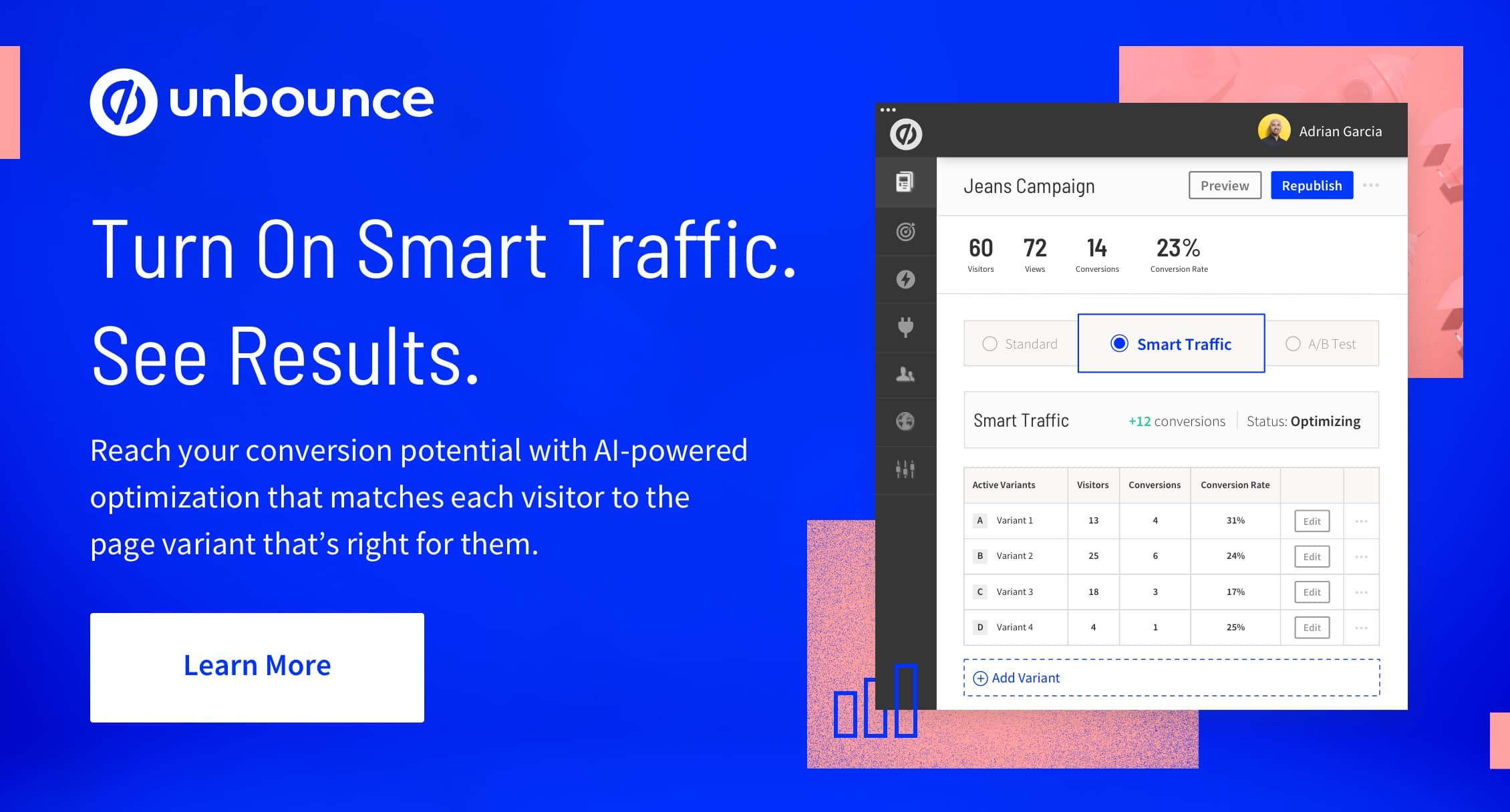5 Rules to Do Landing Page Testing Right (Stop Doing It Wrong!)
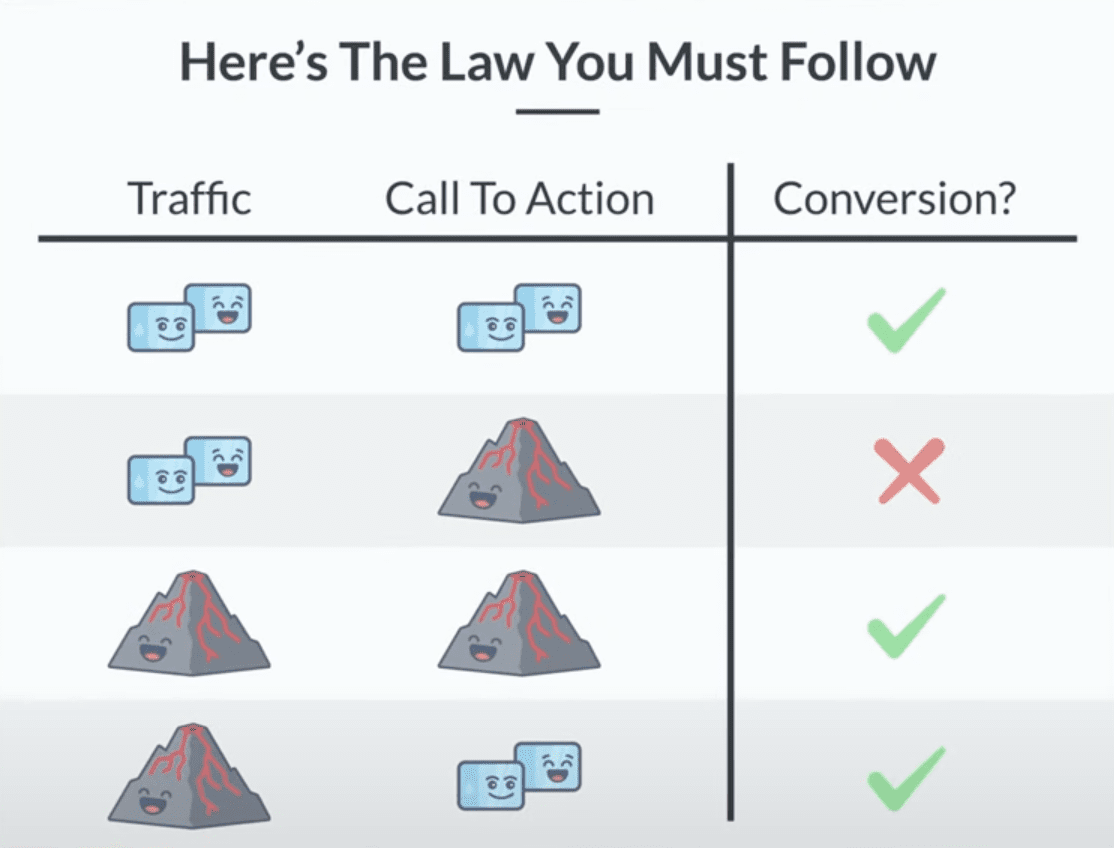
Table of Contents
Most marketers think there is no true winning formula for increasing conversion rates, lowering cost per conversion, and increasing conversion quality all at the same time.
Guess what? There is—I know this because we use it every day at KlientBoost.
Backed by data from 250+ active clients and more than 10,000 CRO tests, we’re seeing these average lifts:
- Increase in conversion rates by 52%
- Lower cost per conversion by 33%
- Increase conversion quality by over 100%
We know. It sounds too good to be true. *eye roll*
How does the KlientBoost team do it? Too many conversion-happy marketers race to split test poor hypotheses and arbitrary landing page elements before setting their landing page foundation first.
Instead, we focus our agency powers on:
- Prioritizing a small group of low-effort tests we know to deliver the highest impact in the shortest amount of time.
- Baking control and structure into our process so we can produce repeatable, predictable, and reliable results.
- Pairing that strong foundation with Unbounce’s Smart Traffic to scale performance and reach client goals faster.
There are marketing rules you never want to break (if you want successful tests) and I’m going to share exactly how KlientBoost gets there.
When Landing Page Testing Goes Wrong
Nearly every article on landing page testing lists the following culprits as the main reasons why tests fail:
- Poor insights: Too many landing pages don’t collect data via heatmaps, session recordings, form analytics, or conversion tracking. This leads to ill-informed hypotheses about what to test.
- Poor hypotheses: Because marketers then misdiagnose the problem, their proposed solution also fails. Or worse, they rush to test arbitrary variables like button color, without a real hypothesis to begin with.
- Not enough traffic: You can’t run a reliable A/B test with 200 visitors. You need volume to reach statistical significance (multivariate tests need even more volume than A/B tests). Most landing pages lack volume.
- Not enough time: You also can’t run an A/B test for one week and expect reliable results. Volume takes time, and time takes money—money (and patience) that many don’t have.
These articles aren’t wrong. Sound landing page experimentation does require insights, hypotheses, volume, time, budget, and, most importantly, execution.
So how can you get it all done, you ask?
The 5 New Rules of Landing Page Testing
You can run as many A/B tests as you want, but we’d rather have you run tests that rely on five landing page rules that KlientBoost has found to be essential.
- Traffic conversion intent must follow call-to-action (CTA) intent.
- Focus aggressively on the offer itself.
- Use the Breadcrumb Technique on your forms.
- Don’t stop at the “Thank You” page.
- Go all-in on Smart Traffic.
Let’s explore each.
1. Traffic Conversion Intent Must Follow Call-to-Action Intent
Conversion intent refers to how likely your ideal customer is to convert.
Low intent (“cold traffic”) = Visitors who may not know the brand, who only want to gather information, and who haven’t expressed an intent to convert.
High intent (“hot traffic”) = Visitors who most likely know the brand, who want to buy right now, and who will convert on all CTAs.
Let’s use a B2B SaaS example.
A high-intent visitor is someone who visits a landing page on their own via a direct visit, branded paid search ad, retargeting ad, or organic search, and converts on a “book a demo” CTA.
A low-intent visitor is someone who visits a landing page via a display ad, an informational Google search, or a native audience on Facebook, and has no intent to convert.
If your CTA doesn’t match your visitor’s conversion intent, it doesn’t matter what you split test on your landing page—it won’t work. For example, if you’re asking cold display traffic to convert on your “book a demo” CTA, it doesn’t matter what your headline says or hero graphic looks like—they’re unlikely to convert.
And here’s the kicker: Even if a conversion does happen, it’s extremely unlikely that that conversion will actually lead to a sale.
Why? Because the higher the intent of the visitor, the more momentum there is throughout the marketing and sales funnel. This is what ultimately leads to a sale.
When it comes to intent, different channels signal different intent levels. So step one of landing page testing is to ensure your traffic and CTAs align with one another. At KlientBoost, we call this the Ice Cube and Volcano Scale:
For example, someone who’s passively scrolling LinkedIn (who isn’t part of any custom audience) clearly has a different intent than someone who searches for “Gusto HR software demo” on Google.
That’s because on social you can target native audiences and retargeting audiences, and it’s not an intent channel like paid search is. That’s why many LinkedIn paid campaigns fail when there’s an attempt to drive bottom-of-funnel (BOFU) conversions on a native LinkedIn audience.

You can’t run a “book a demo” ad to a group of Instagramers who have never heard of you, haven’t signaled intent, or are part of a specific audience with intent (like Lookalikes on Facebook/Instagram) to buy and expect a landing page A/B test to save the day.
Not gonna happen.
When channel, CTA, and intent are in harmony, only then will an A/B test produce more meaningful results. To do that, you must first bucket your traffic into conversion intent categories.
For example, in Google, divvy up your branded, competitor, generic, and informational keywords into different campaigns. In Facebook, separate your custom, lookalike, and saved audiences into different ad sets. Then, route traffic to CTAs based on intent accordingly.
This will be your first, biggest foundational landing page win. Oh, and don’t forget—if you suffer from The Iceberg Effect, your traffic splits won’t matter.
If you’re not excluding audiences from each other on social, then you’ll have Venn diagram overlaps that can hurt you (one way to avoid this is to exclude custom audiences from your lookalike audiences).
Same with paid search: Make sure your search terms actually match your keywords.
2. Focus Aggressively on How the Offer Is Presented
We’ve run countless tests at KlientBoost where we’ve removed everything below the fold. We’ve purposely and randomly chosen copy for headlines and subheadlines. Time and time again, we’ve found that visitors immediately focus on the CTA and how it’s worded.
Increase motivation with CTA copy
Oftentimes, you don’t need to change your offer or conversion goal to increase conversions. You just need to create motivation by changing your CTA copy to something your visitors find more compelling.
For example, we’ve experimented with five different CTAs and headline/subheadline variations for our marketing plan offer:
- Get free trial
- Get free audit
- Get free proposal
- Get free marketing plan
- Start my pricing calculation
Nothing about the offer changed—only the headline/subheadline and CTA copy. Well, that and conversion rates progressively increased with each iteration of our CTA copy.
Version 1: 14-day free trial
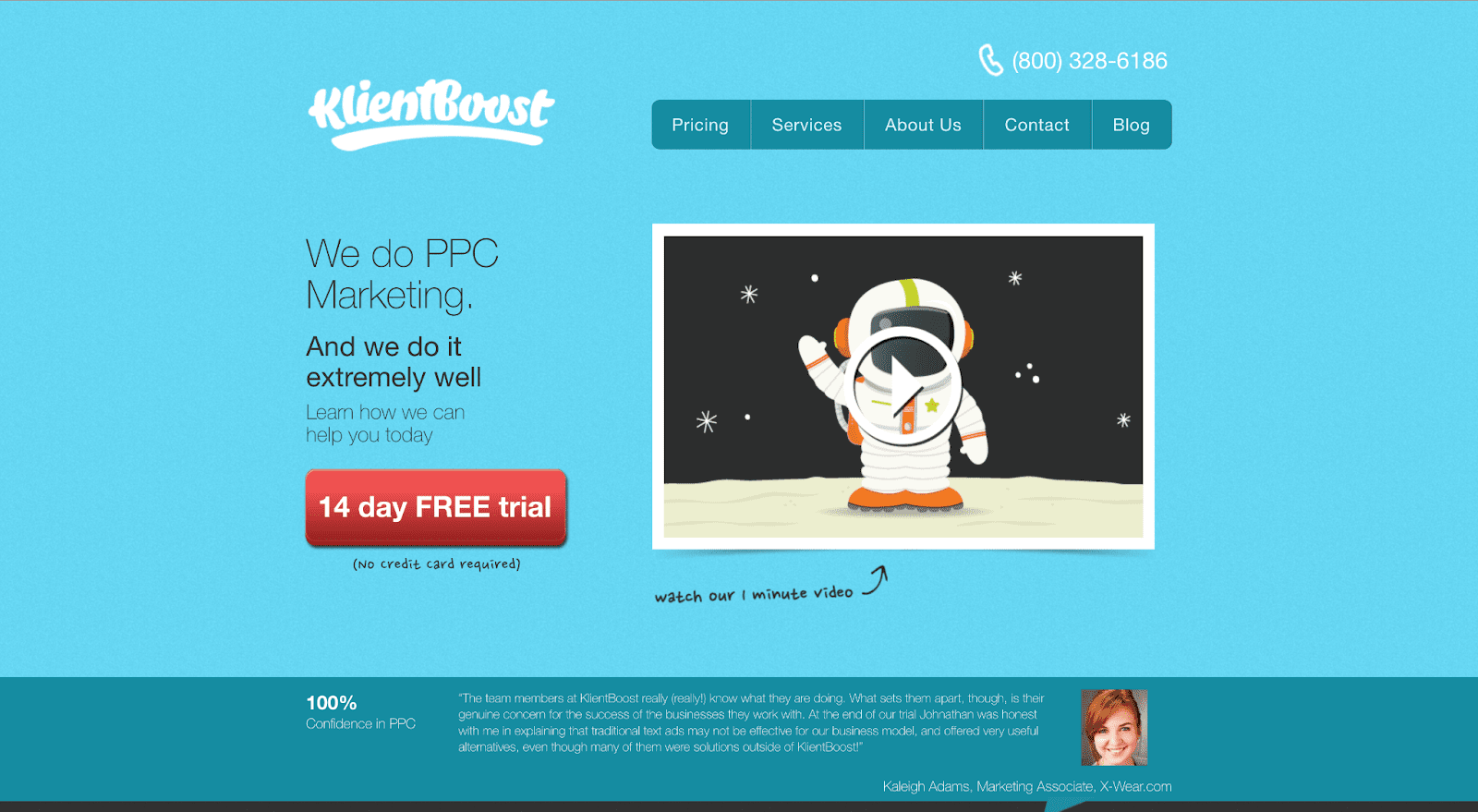
Version 2: Get free proposal
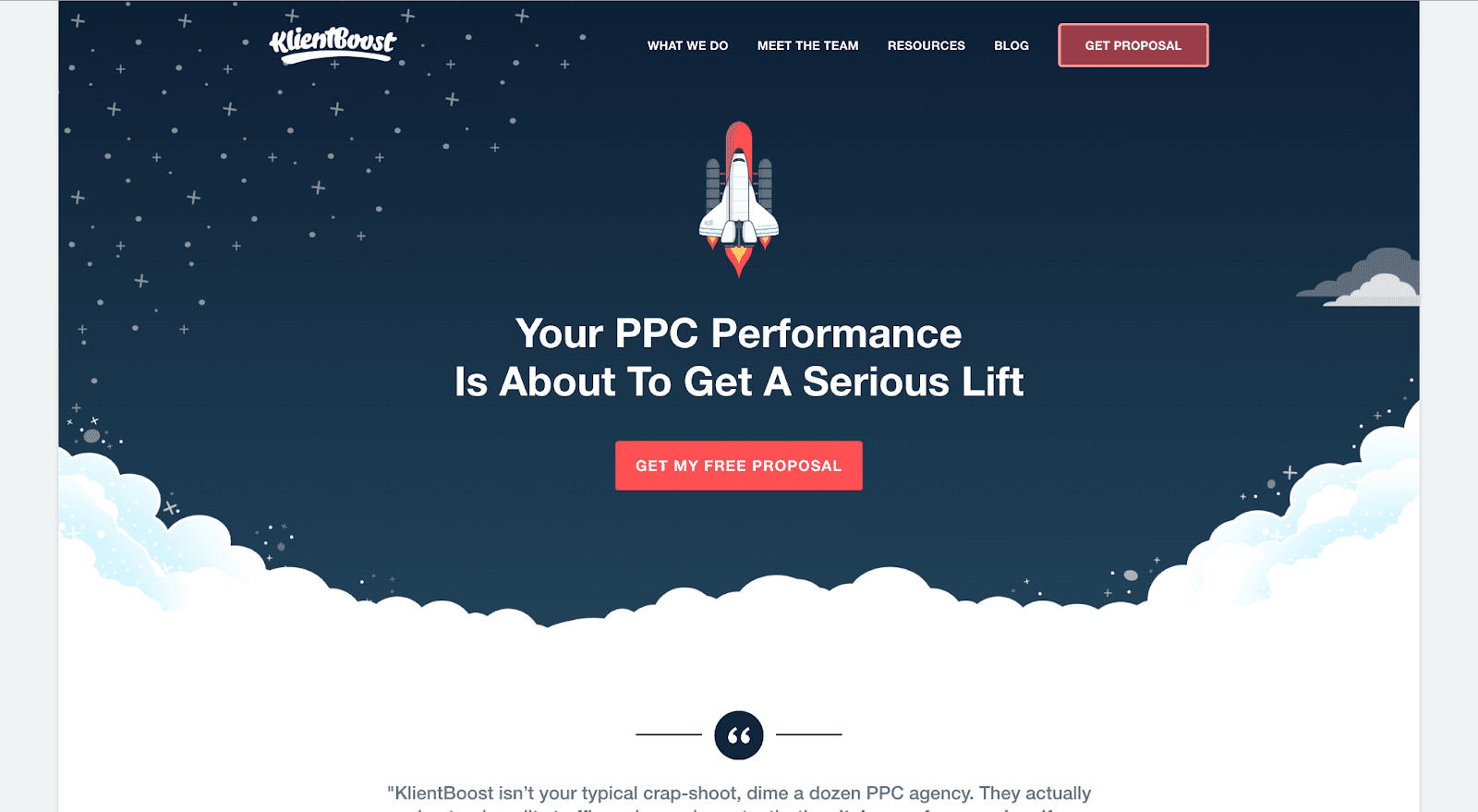
Version 3: Free marketing plan
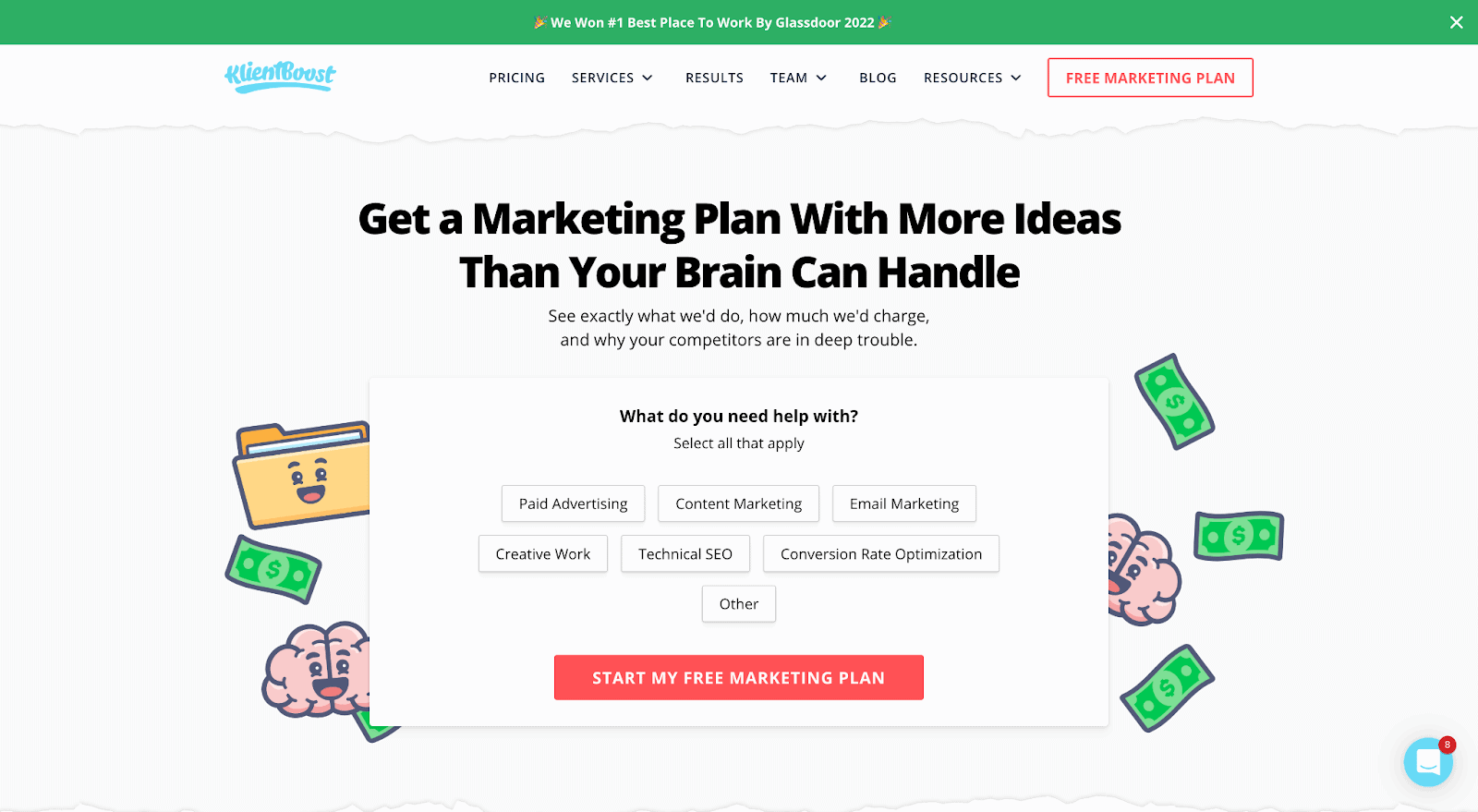
Version 4: Pricing calculation
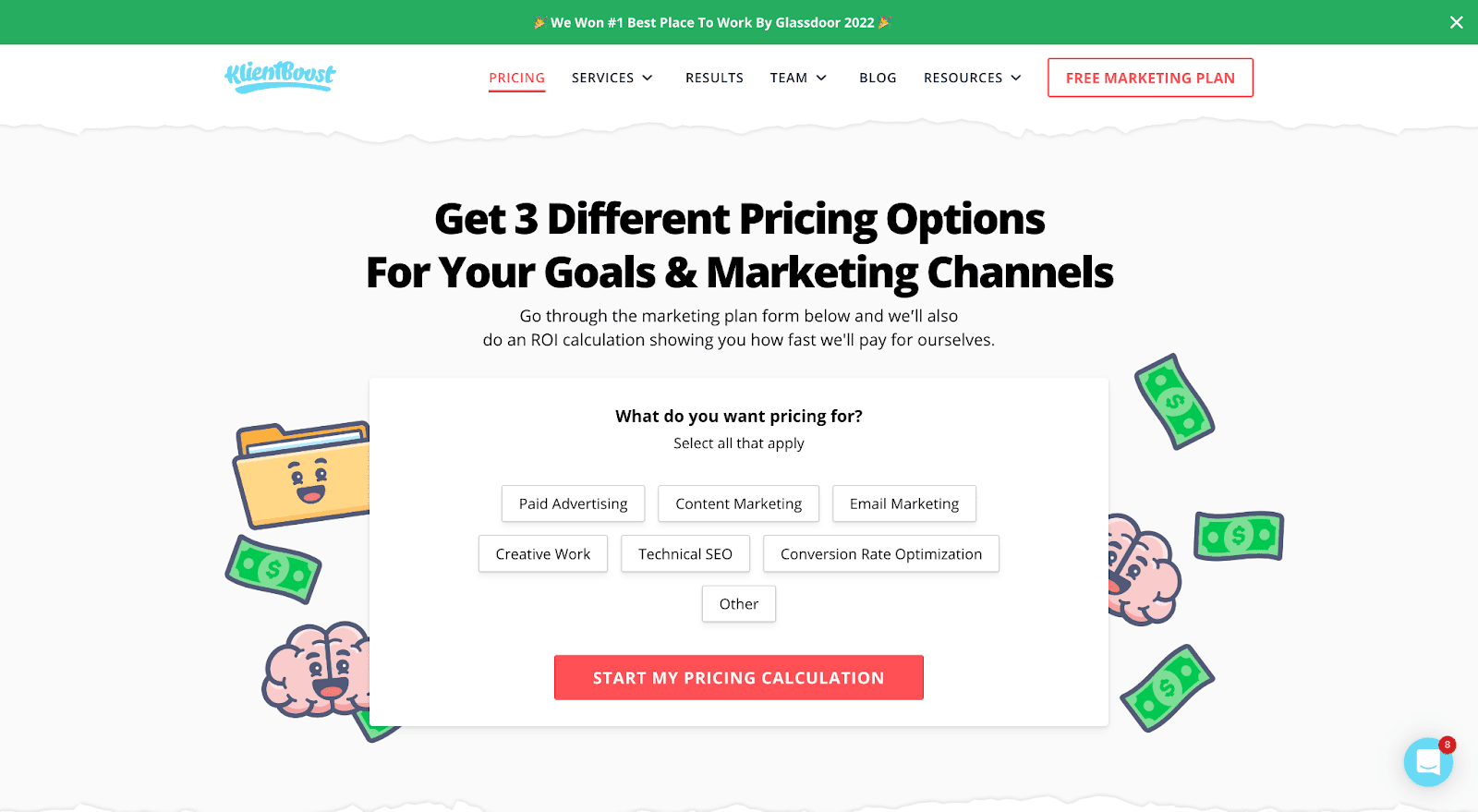
All four versions, while expressed differently, all ultimately lead to the same conversion goal: a consultation with the sales team.
By testing different headlines and CTAs, we were able to build motivation and, as a result, increase conversion rates without ever changing the offer.
Why do we swear by CTA copy? Low effort, high impact. Simple.
Above is just our own example. Let’s say we’re dealing with personal injury lawyers: 99% of them use “Free Consultation” as their main CTA. If they’d switch their CTA to “See If I Have a Case” or “See What My Case Is Worth,” then they’ll get higher conversion rates while STILL having a consultation.
The magic trick here is to marry the main questions/objections your visitors have, and turn that into a CTA that promises answers.
3. Use the Breadcrumb Technique on Your Forms
You may have heard otherwise, but fewer fields do not automatically equal higher conversion rates. (It depends on a number of factors, really.)
For lead capture landing pages, forms can make or break conversions. But more importantly, the first impression your visitors have of your form’s fields will make or break conversions.
Form layout, number of fields, field labels, field order, placeholder text, button copy, radio button vs. drop down—the list of testable features never ends. But every form split test should prioritize one experiment above all: Adding multiple form steps while changing the order of the fields.
A form using the Breadcrumb Technique separates form fields into at least two progressive stages rather than placing them all on one single form. For example, KlientBoost’s “free marketing plan” form includes four forms with multiple fields (pictured below).
While a standard form might show all fields in a single column, our multi-step form breaks up six fields into four very digestible stages. Visitors don’t see Step Two until they complete Step One, and so on.
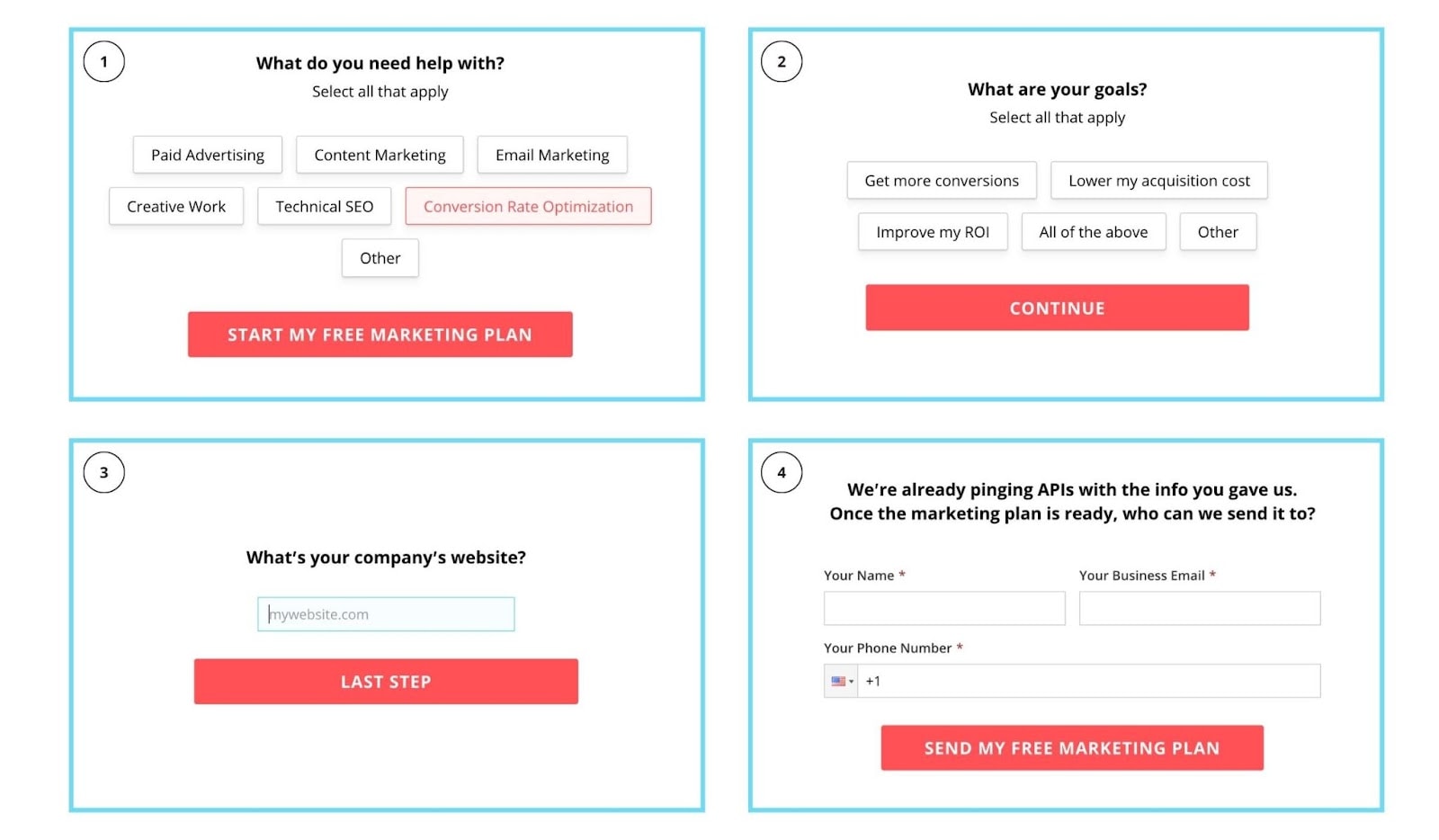
Why multiple steps? Three reasons:
- Compliance psychology
- Lead quality
- Results
This is the Breadcrumb Technique, aka the method of persuading people to commit to your request by getting them to commit to a smaller request first.
Behavioral psychologists like Robert Cialdini call it the “Consistency Principle of Persuasion.” In layman’s terms, when people actively commit to something, they’re much more likely to complete it. Simple.
A multi-step form leverages this principle of psychology by placing your most threatening form fields last (contact information) and your least threatening form fields first. By asking non-threatening, non-intrusive questions first, you make it easy for prospects to actively commit to your form. And once they commit, they’re more likely to complete it.
Let’s look at another example from Lytx, one of our clients.
Notice how the first two steps of the form ask softball questions and the last two steps ask for personal information (email, phone, name).
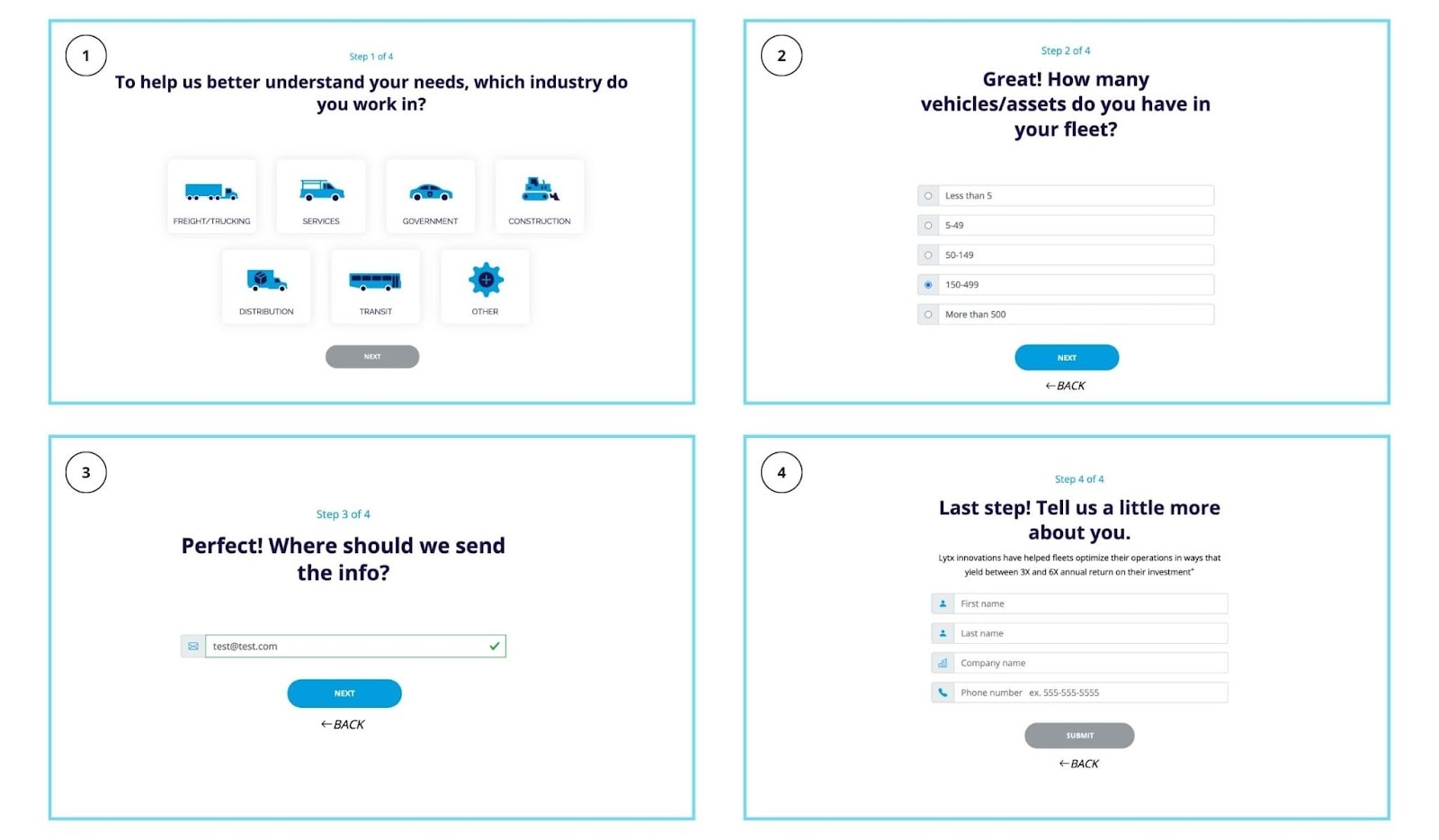
Bottom line: Multi-step forms increase conversions. Like, by a lot.
For example, by converting Lytx’s form from one step to multiple steps (and asking for name, phone, and email during the last step), we increased their conversion rate from 1% to 20%, increased lead volume from six to 135, and decreased CPA by 95%. Dang.
4. Don’t Stop at the “Thank You” Page
Raise your hand if you’ve filled out a landing page form and received the following confirmation message:
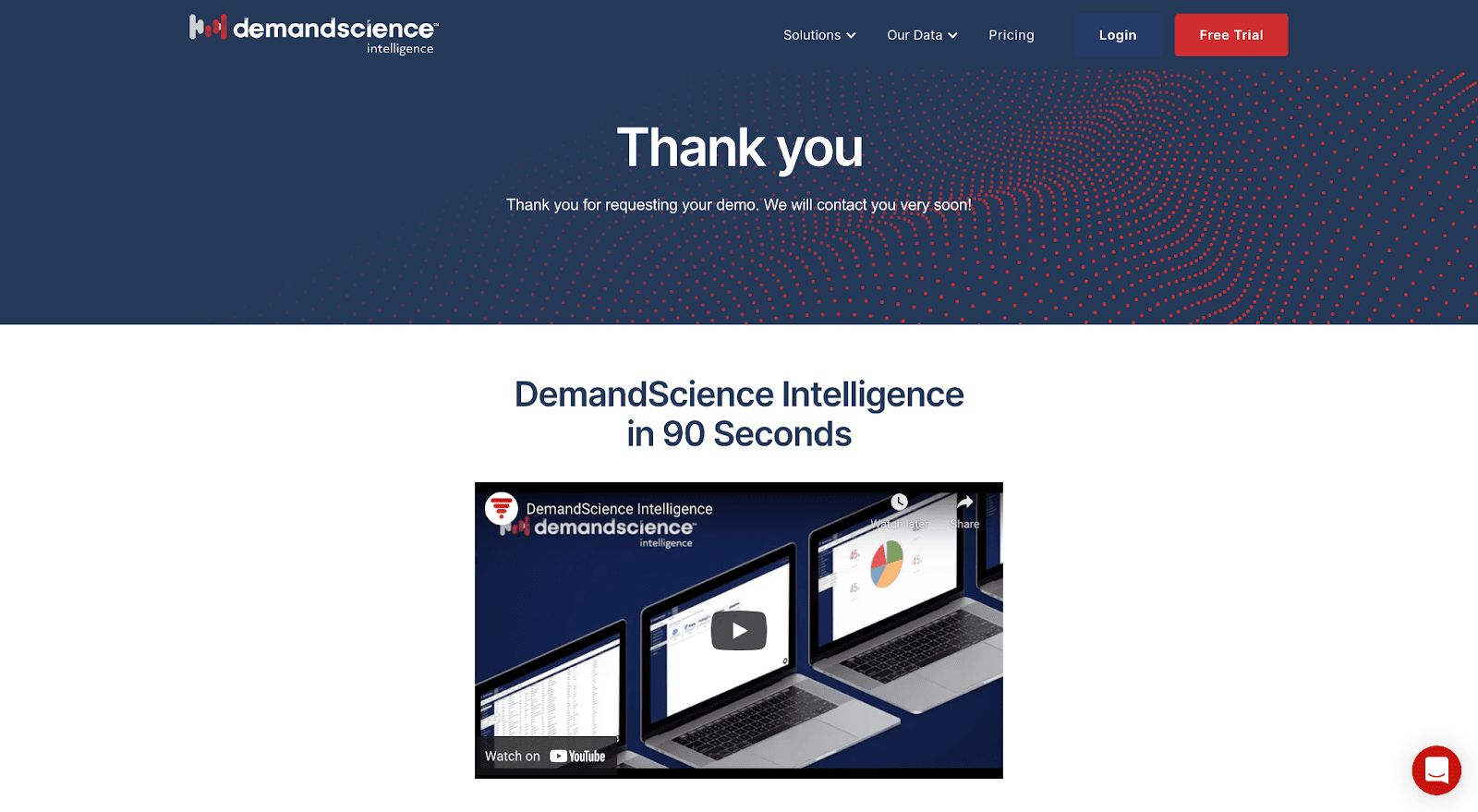
*All hands go up*
Now juxtapose that with ChiliPiper’s confirmation page:
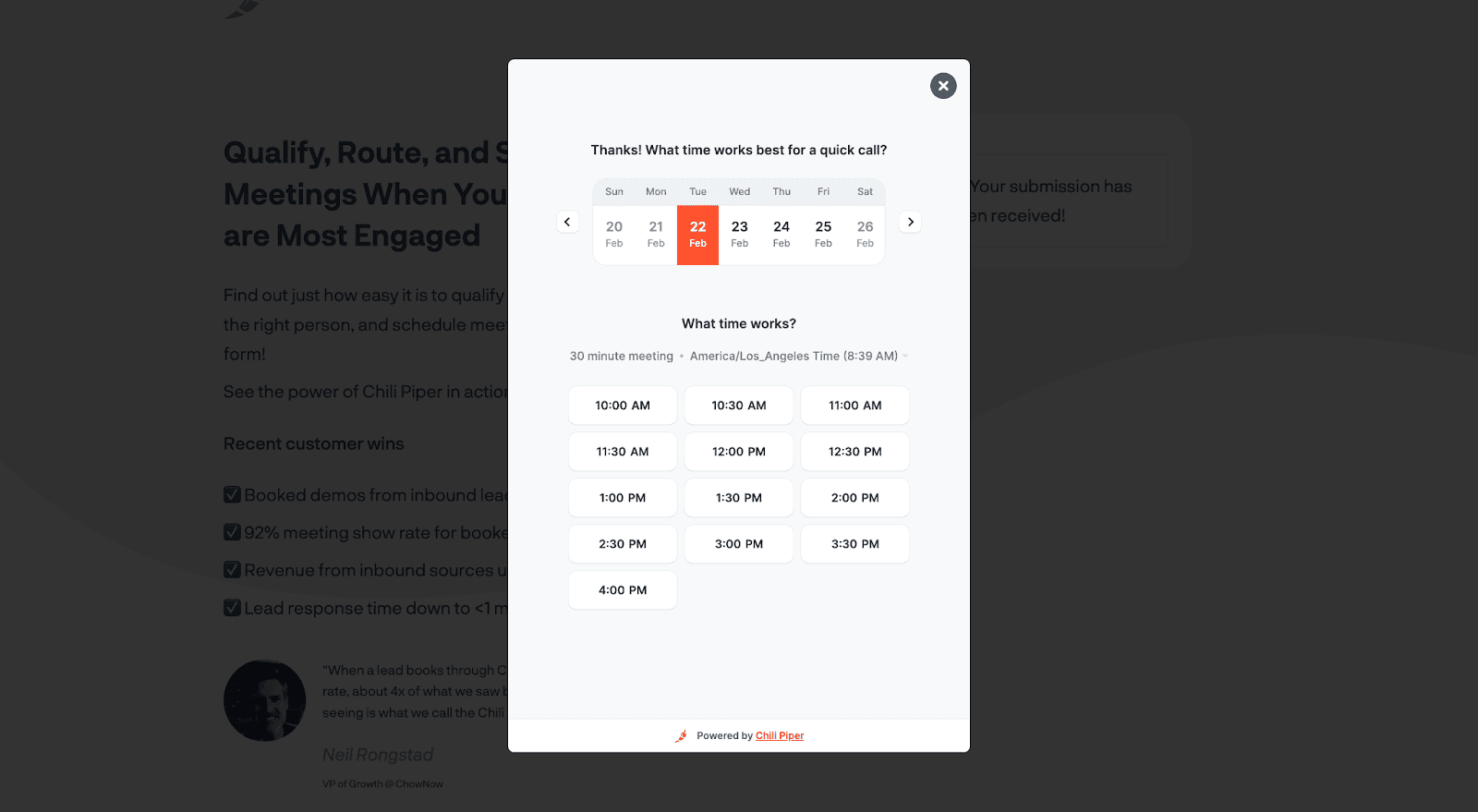
DemandScience (like nearly everyone else) kills conversion momentum by making you wait for a sales rep to follow up. And for what? To go back and forth via email to schedule a demo anyways?
Like ChiliPiper does with their calendar, use your thank you/confirmation page to move prospects to the next step in the conversion funnel (and closer to revenue) quicker.
“But what about lead qualifying/scoring?”
If you listened in Step One (see: conversion intent), the only sources of traffic who encounter your “demo” request offer (or the “high intent” equivalent of your industry) are those who are ready to buy anyway. No scoring needed—move them to “qualified” immediately.
Note: The next step toward revenue doesn’t necessarily mean a massive PDF download or resource guide. In fact, in most cases, it doesn’t. The point of this step is to test the efficiency of your funnel.
When high-intent buyers convert on your CTA, make the process as frictionless as possible. You already know the data surrounding the ability to close a lead with more time that goes by.
Here are some things you can try out:
- Have a calendar widget on your thank you page and hire an extra sales development rep (SDR) to source which leads are high-quality or not. You’ll have people who aren’t qualified today, but will be qualified six months from now. Give everyone the white glove experience.
- If you can’t do that, tell people which email address or phone number will reach out to them. In the world of spam or robo-calls, you’ll get ghosted even by people who converted—this will alleviate that.
- Tell people when they can expect to hear from you. “In the next 24 hours,” “next 30 minutes,” etc. Give them that explicit heads-up.
You spent this much time and effort to get the conversion, so don’t screw up the momentum of the deal because of your un-optimized thank you/confirmation page. Do better.
5. Go All-In on Smart Traffic
Now that your landing page testing fundamentals are stronger than ever, it’s time we call in help from our AI friends.
Smart Traffic is Unbounce’s AI-powered algorithm that matches visitors to the variant they’re most likely to convert on.
Unlike traditional A/B testing, Smart Traffic doesn’t crown a single variant as the champion. Instead, it analyzes how distinct groups of people convert differently on several variants. Smart Traffic then funnels each respective group to the variant they’re most likely to convert on.
For example, in the graphic below, notice how a traditional A/B test leaves conversions on the table, but Smart Traffic doesn’t:
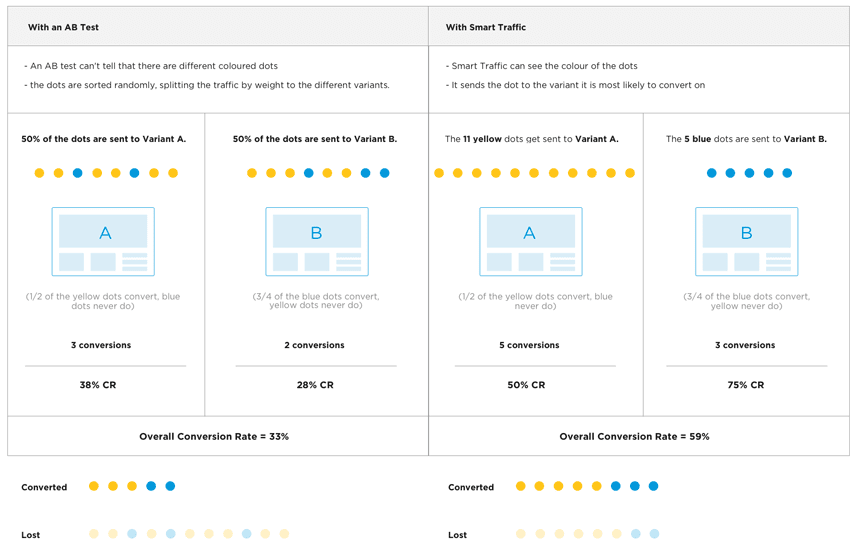
The truth? A/B testing isn’t going to work for many of you. It requires too much expertise, commitment (duration), traffic volume, and ad budget to work effectively. Most small businesses simply don’t have the resources for this.
But they have the resources for Smart Traffic.
Smart Traffic converts quicker with as few as 50 visitors, lets you test multiple variants at the same time, and works with multiple traffic sources at once. Plus, it does all the analysis for you.
For most of you reading this, Smart Traffic will prove more effective than A/B testing (unless you have the resources on deck).
Test Better—or Better Yet, Get Smart Traffic
Here’s the bottom line: You can run as many A/B tests as you want (and many marketers do), but unless you get your house in order first, landing page testing isn’t going to provide consistent or reliable results.
You need fundamentals and prioritization above all. After you’ve prioritized and built a strong foundation, you can start testing low-effort/high-impact experiments like CTA copy, multi-step forms, and thank you pages.
Even then, you might find that you don’t have test duration, traffic volume, ad budget, or expertise to run effective landing page tests anyway.
If that’s the case, you should seriously consider Unbounce’s Smart Traffic. It’s the perfect starting point for novice CRO specialists and digital marketers to improve the performance of their landing pages.
